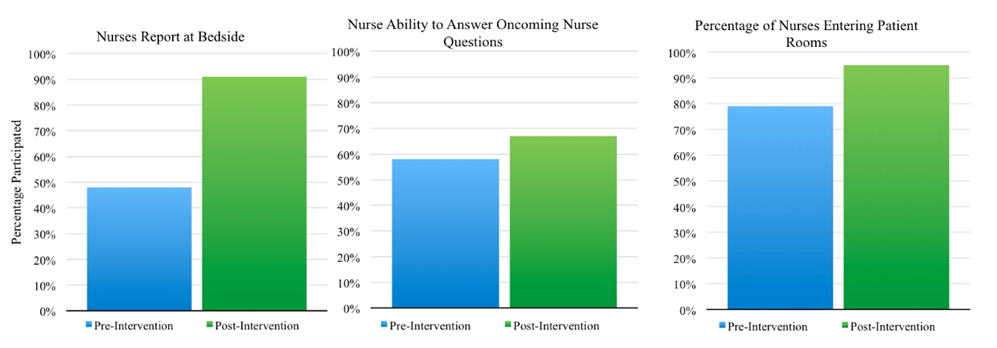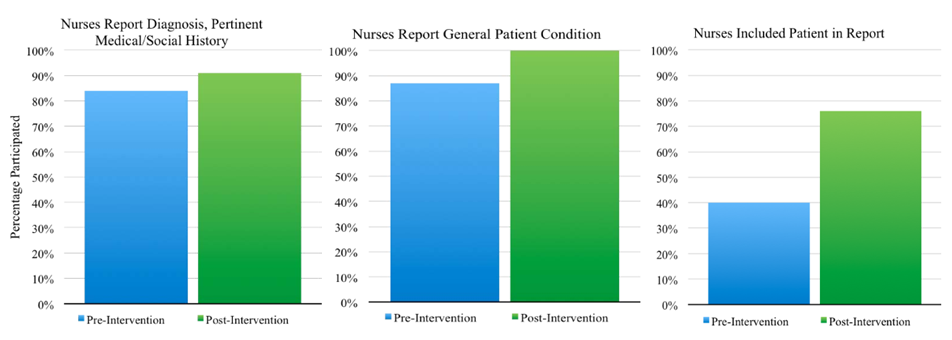Findings
The current research utilizes the secondary data for the survey conducted at Washington Regional Medical Center regarding the implementation of the bedside reporting procedure in 2014 (Szeto, Wren, & Milborn, 2014). Nurses of the cardiac department at Washington Regional Medical Center participated in the survey to examine their perceptions of bedside reporting after the procedure implementation and after the additional intervention to educate the nursing staff regarding the aspects of this type of report. While comparing the nurses’ perceptions of bedside reporting before and after their focuses on the procedure’s details and benefits, it was found that more than 90% of nurses began to leave bedside reports for their colleagues in contrast to about 50% of nurses that had provided reports before they learned about their advantages and disadvantages. More than 65% of nurses noticed that they could answer the questions of oncoming nurses better, using bedside reports (Szeto et al., 2014). Nurses’ perceptions of discussions of patients’ states near their beds also changed, and 95% of nurses chose to enter the patient room in contrast to about 80% of nurses who had done it previously (Figure 1).

Despite the presence of the additional educational intervention, more than 80% of nurses were inclined to use bedside reports to find information regarding the patient’s medical history and social conditions. Bedside reports are also perceived as valuable sources of information regarding the current patient condition in terms of surgery, necessary devices, necessary treatment, and other aspects, as it was noted by 100% of nurses after the intervention. The significant growth in positive attitudes and behaviors was observed about the involvement of patients in the discussion of their conditions during the bedside reporting strategy (Szeto et al., 2014). Before the intervention, only about 40% of nurses communicated with patients; after the additional comments on the procedure’s benefits, the number of nurses following this part of the procedure increased by more than 35% (Figure 2).

The findings indicate that nurses actively use bedside reports in their practice, and they have positive perceptions of this procedure that can even increase after the additional discussion of the procedure’s benefits.
Discussion
The purpose of this research was to determine the effective approach to bedside reporting, as well as the associated scheme. Moreover, it was necessary to discuss the relevance of the procedure to the nursing practice in terms of reducing the possibility of errors and improving the communication and cooperation between nurses, as well as between nurses and patients. It was found that the bedside reporting should be implemented in healthcare facilities because this procedure allows focusing on precise reports left by nurses for the oncoming staff, and the discussion of the patient state with the other nurse or with the patient near his or her bed is possible to contribute to the accuracy of the received information. The majority of nurses discuss bedside reporting as a procedure that can improve their communication with each other (Sand-Jecklin & Sherman, 2013). Nurses prefer to use standard forms of beside reports to decrease the possibility of medical errors due to the misunderstanding or the lack of information in reports (Laws & Amato, 2010; Tidwell, Edwards, Snider, Lindsey, & Reed, 2011). Following the bedside reporting procedure, nurses can ask questions related to the patient’s state near the bed and receive the nurse’s comments.
Also, nurses are inclined to note that bedside reporting allows the effective involvement of patients in the process of discussing the care and updated information regarding the treatment (Hagman, Oman, Kleiner, Johnson, & Nordhagen, 2013). As a result, the accountability and the quality of the provided care can increase significantly (Sand‐Jecklin & Sherman, 2014). Therefore, nurses report positive changes in their perceptions of bedside protocols as an effective tool to minimize errors and maximize cooperation with patients. Bedside reports usually include the information regarding the patient state, conducted procedures, and medications that can be addressed immediately while communicating in the patient room and covering gaps in the available information. Therefore, nurses focus on the possibility to decrease the risks of errors while using bedside reports.
Conclusion
The problem of the minimal cooperation between nurses and patients and the problem of the insufficient change-of-shift reports can be directly solved with the focus on the implementation of bedside reporting in healthcare facilities. Even though nurses have positive perceptions regarding the use of bedside reports in their practice, and the majority of nurses use them regularly, the additional educational intervention explaining the benefits of the procedure and the aspects of its implementation can even improve the results. The potential of bedside reports to advance the procedure of exchanging the data between nurses is significant because this reporting strategy can reduce the number of possible errors and provide nurses with the concise and relevant information that can be checked with the help of the communication with patients.
References
Hagman, J., Oman, K., Kleiner, C., Johnson, E., & Nordhagen, J. (2013). Lessons learned from the implementation of a bedside handoff model. Journal of Nursing Administration, 43(6), 315-317.
Laws, D., & Amato, S. (2010). Incorporating bedside reporting into change‐of‐shift report. Rehabilitation Nursing, 35(2), 70-74.
Sand-Jecklin, K., & Sherman, J. (2013). Incorporating bedside report into nursing handoff: Evaluation of change in practice. Journal of Nursing Care Quality, 28(2), 186-194.
Sand‐Jecklin, K., & Sherman, J. (2014). A quantitative assessment of patient and nurse outcomes of bedside nursing report implementation. Journal of Clinical Nursing, 23(19), 2854-2863.
Szeto, W., Wren, S., & Milborn, M. (2014). A qualitative study evaluating bedside reporting and the impact on nurse satisfaction and communication barriers with Washington Regional Medical Center. Web.
Tidwell, T., Edwards, J., Snider, E., Lindsey, C., & Reed, A. (2011). A nursing pilot study on bedside reporting to promote best practice and patient/family-centered care. Journal of Neuroscience Nursing, 43(4), 1-5.